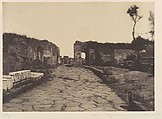Pompeii, Pompey’s Lane, Tomb Monument of Mamia
Firmin-Eugène Le Dien French
Printer Gustave Le Gray French
Not on view
Born in Paris, Le Dien studied law and served as a clerk before relocating to Algiers in 1848. He took up photography as an amateur while working as a deputy magistrate for the colonial government. Upon returning to Paris, he befriended a group of artists, writers, and aristocrats with ties to the photographer Gustave Le Gray. Between 1852 and 1853 Le Dien traveled to Italy with the painters Léon Gérard and Alexandre de Vonne. On a journey to Rome, Naples, Pompeii, and the Amalfi Coast, Le Dien produced architectural photographs of monuments and landscapes using the process of waxed paper negatives invented by Le Gray. This view of Pompey’s Lane is a masterful evocation of the street as a visual marker of history. It bears the stamp Le Dien et Gustave Le Gray, attesting to the successful collaboration between amateur and professional. Le Gray likely printed his protégé’s negative in his own Paris studio.
Due to rights restrictions, this image cannot be enlarged, viewed at full screen, or downloaded.

